Lighting control vendors meet hospital challenges

Hospitals pose many challenges to manufacturers of lighting control systems. They have areas with different lighting requirements, ranging from operating rooms to patient rooms to recovery areas. Lack of product interoperability can make it hard to find controls that work with a broad set of luminaire manufacturers, and trying to manage different control systems can be taxing for facilities managers.
Installing controls on a preexisting lighting system is complex, as it requires preplanning and decommissioning an area to add controls components such as relays and switches. “Often it is hard to break into the ceiling, and having to tape off the room and equipment to complete the project is both labor-intensive and disruptive,” says Umesh Baheti, senior vice president at MaxLite, West Caldwell, N.J.
Identifying benefits
One of the biggest challenges is clearly identifying the benefits, according to Rich Rattray, commercial engineer at LEDVANCE LLC, Wilmington, Mass., the maker of Sylvania General Lighting. The good news, he says, is that research has been conducted within the past year to help identify these benefits.
“In a report published by the Alliance to Save Energy and the Design Lights Consortium, it was concluded that ‘efficiency programs that capitalize on system-level lighting efficiency measures (combining lighting technology upgrades with networked lighting controls) could see an additional 22 percent lifetime energy savings on average,’” Rattray says.
The best solution for hospitals is to specify a singular lighting control system to meet budget needs — one that is flexible and scalable enough to meet various control needs and building code requirements, while still providing a focus on patient/worker comfort and safety.
Hospital administrators prefer simplicity with their control systems because many different people use the space — from day shift to night — so controls have to be easy for staff to learn and use, according to Colette Fleming, director of health care at Balanced Care by Axis Lighting, Montreal. “Due to the nature of the hospital environment, the staff needs to be able to react quickly and often doesn’t have time to train on complicated control systems,” she says.
Smaller, off-campus health care facilities tend to have limited budgets when it comes to lighting renovations and updates. Therefore, the default strategy is to opt for stand-alone controls, which are more functional in performance, according to Rahul Shira, senior product marketing manager at Signify, Somerset, N.J.
“The consequence of this strategy is that it limits the ability of the central office to remotely monitor and manage lighting assets. This forces satellite facilities to invest in local electricians and maintenance staff and opt for a siloed approach, which could result in a mix of control platforms that can get outdated,” Shira says.
Remote sites usually don’t have large facility management staffs. Also, because of their smaller footprint, the potential benefits of energy savings are less significant, adds James Tu, chairman and CEO of Energy Focus Inc., Solon, Ohio.
“However, by adopting room-based, modular lighting control systems that don’t require additional wireless or wire line deployment and IT support, the barrier due to scale could be eliminated,” Tu says. “These smaller facilities could adopt lighting controls based on the actual needs for each space instead of the entire facility and still reap the energy, sustainability and health benefits of controlled lighting.”
Innovative solutions
Manufacturers are offering innovative lighting control systems to overcome health care challenges. “One innovation we’re seeing is simplifying fixture design in patient rooms by combining what historically has been multiple fixtures into one fixture,” says David Buerer, director of product management at Leviton Manufacturing Co., Melville, N.Y. “The control system operating these fixtures and the interfaces that support them can be easily scaled and operated based on the number of lighting zones needed for the space.”
Buerer also sees highly advanced control technology being used to support specific patient healing needs. For example, recovery rooms in hospitals are using circadian rhythm and color-tuning technology to simulate morning time, which research has shown promotes quicker recovery time. “Through a control interface, hospital staff can change the lighting in a specific zone to simulate morning time with the press of a button,” Buerer says.
The health care market is growing rapidly, which is allowing vendors to consider controls integration at the front end of facility design rather than retrofitting an existing facility, Fleming says. “We’ve had requests for various interfaces that include wireless controls, and even sophisticated Power over Ethernet (PoE) design where the IT department contributes to the selection of the lighting, which is a departure from traditional specification,” Fleming says. “One of the biggest advantages of PoE is scalability and ease of installation; it’s low voltage and eliminates the need for 120/277-volt wiring.”
The Internet of Things (IoT) continues to play an important role in the evolution of lighting control systems in hospitals, as it helps support the scalability of these systems. “Given that the lighting grid is fixed, we can now use the lighting infrastructure to add more control devices to achieve advanced use cases. BACnet integration allows for controlling HVAC and security systems through the lighting network,” Baheti says.
Due to accelerating miniaturization of microprocessors and sensors as well as expanding capabilities of software and the cloud, lighting control systems will continue to be integrated with more IoT applications, such as temperature, humidity or voice sensors, and building automation systems, into fixtures, lamps and switches, according to Tu. “Also, the rapid rise of edge computing will make such lighting systems more powerful without the need for centrally located servers that require heavy IT involvement.”
As IoT grows for lighting controls, and systems become more connected to facility network infrastructures, security has become a growing concern, Buerer says. “Leviton is taking the need for secure control systems seriously and certifying solutions by ioXt, the IoT security alliance. The goal of the group is to build consumer confidence in the security of these products.”
Something new
Lighting control systems recently introduced to the health care market offer scalability and ease of installation, and designs that maximize light levels and energy savings. They also allow facilities managers to focus on the effect they want the lighting to have on patients and visitors.
Acuity Brands Lighting Inc., Atlanta, recently introduced a wireless repeater technology for its nLight lighting control system, called autonomous bridging technology. It is used to create wireless networks with a broad wireless range and reliability, offering a single lighting control system across a variety of space types, indoors and outdoors.
“This is a good example of how leveraging wireless products can lower installation costs and allow for simple space renovation, while still providing the flexibility of a lighting control system that can work in the variety of spaces common in health care facilities,” says Steve Roe, vice president of controls solutions at Acuity Brands.
Cooper Lighting Solutions, Peachtree City, Ga., has introduced the WaveLinx Lite lighting control system, a wireless solution that allows users to maximize light levels and energy savings based on occupancy detection. The system can be upgraded to WaveLinx Wireless, which provides additional functions around lighting-specific features such as HVAC control, BACnet communication, shade control and open automated demand response. It can be connected to the company’s IoT platform, Trellix. A low-voltage wired solution is available as an option to the WaveLinx Wireless system.
MaxLite recently introduced c-Max Lighting Controls, a luminaire-level lighting control solution that can address some of the pain points associated with installing controls in certain areas of older hospitals or off-site facilities. The key benefit is that one can use a controls-ready luminaire or a retrofit that comes pre-installed with a controls receptacle.
“End users can then add a sensor node that is field-installable and easy-to-commission while making the installation future-ready for controls,” Baheti says. “The plug-and-play interface allows one to upgrade from basic controls to network controls, which means you can group lights, create scenes and set schedules.”
Signify recently introduced the Interact Pro scalable system, which offers flexibility and can be scaled according to a facility’s needs. “It can be set up in a stand-alone mode without IT support, so one can derive energy savings, for example, with automated, sensor-based behaviors and grouping lights in logical areas,” Shira says. “But the best part is that the same stand-alone system can be scaled up to a connected mode for remote monitoring and management capabilities across multiple facilities.”
The system is compatible with retrofit solutions such as lamp replacements or retrofit kits as well as luminaires for new construction projects.
Energy Focus has introduced the EnFocus lighting control platform, which provides flicker-free, dimmable and color-tunable lighting through simple lamp and switch replacements. “The lighting platform is compatible with building electrical systems with both two- or three-wire power lines operated from 120 to 277 volts, making it universally accessible without requiring complex wireless protocols or additional data cables,” Tu says. The company plans to launch a next generation EnFocus, which will feature autonomous circadian lighting and occupancy sensing capabilities.
Many vendors provide lighting fixtures that feature inherent control technologies. LEDVANCE has partnered with lighting control manufacturers — Lutron, Enlighted and OSRAM — to offer Sylvania LED fixtures that feature various control capabilities. The fixtures are delivered to a site with the sensors and controls already installed, simplifying the installation process and optimizing end-user payback.
Balanced Care by Axis Lighting has introduced a line of luminaires that can be controlled through a building automation system or as stand-alone products with localized control. “Our lighting products are ‘controls agnostic,’ meaning we have a lab at our factory and test every luminaire with various suppliers’ controls to assure compatibility,” Fleming says.
Legrand, West Hartford, Conn., has expanded its line of digital lighting management (DLM) to include motorized window treatments that integrate with the company’s Wattstopper DLM controls. “Legrand took the ease of installation and commissioning of DLM controls and built the DLM Shade system, which is optimized by digital intelligence,” says Scotty Jones, senior health care applications engineer. “The shading has an override feature that allows for easy manual operation. Also, its mold- and bacteria-resistant fabrics are ideal for hospital environments.”
Lighting controls also extend to hospital parking garages. Kenall Manufacturing, Kenosha, Wis., offers TekDek and SenScape parking structure lighting, which features four control systems ranging from wired to cloud-based. TekLink controls are designed to maximize energy savings. The latest system offers embedded camera technology, which performs tasks such as car counting and license plate recognition. TekLink has been installed in the parking structures of many hospitals.
Human-centric future
What advances do lighting control vendors see in the near future? Jones predicts that more hospitals will employ a human-centric lighting approach by utilizing tunable light to align lighting with patients’ circadian rhythms. “We also see more demand for fully integrated solutions in patient rooms that simplify the control of shades, pillow speakers, tunable lights, HVAC and traditional lighting for the patient,” he says.
Roe agrees that, as lighting control systems continue to advance, the field is likely to see a continued focus on patient comfort in hospitals, with human-centric lighting more prominent in these spaces. “Additionally, given the dense sensory network often available with lighting control systems, real-time location services through lighting infrastructure is likely to continue driving efficiency in health care facilities,” he says.
Neal Lorenzi is a freelance writer and regular contributor based in Mundelein, Ill.
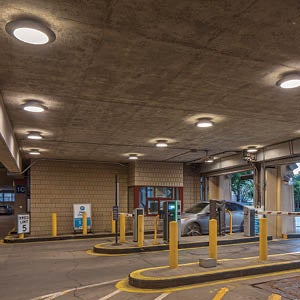
SAFE SPACES
Available in wireless and cloud-based configurations, TekLink controls provide safety and energy savings in large parking structures. Kenall Manufacturing
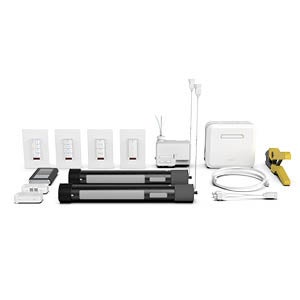
THROWING SHADE
DLM Shades integrate with networked lighting controls to provide patients with control over electric and natural light in their rooms. Legrand
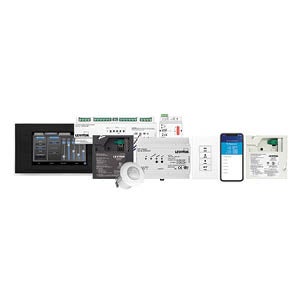
BEGINNING TO END
GreenMAX DRC improves lighting control at every level of the process — easy specification and design, low-cost installation and convenient end-user control capabilities. Leviton Manufacturing Co.
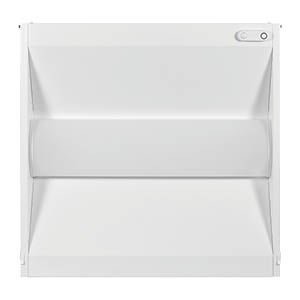
READY TO RUN
Sylvania UltraLED retrofit door kits feature control capabilities already installed. LEDVANCE LLC

PROJECT FLEXIBILITY
This wireless, battery-powered ceiling mount sensor is designed for retrofit or new construction projects. Acuity Brands Lighting Inc.
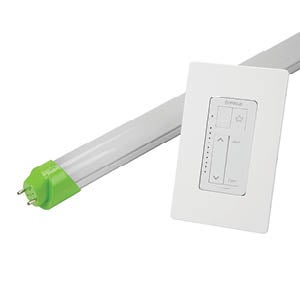
TUNING IN
he EnFocus lighting control platform offers retrofittable and human-centric lighting that delivers low-flicker, 10-stage dimming and color-tuning capabilities. Energy Focus Inc.
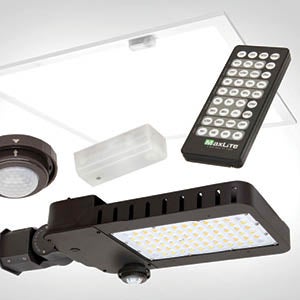
EXTRA SAVINGS
c-Max Lighting Controls make it easy to add luminaire-level lighting controls to achieve energy savings beyond LED conversion in health care facilities. MaxLite
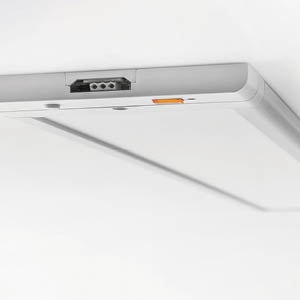
LOOK OUT BELOW
nder-cabinet light features sensor-enabled, touch-free on/off and dimming, and multiple correlated color temperature choices. Balanced Care by Axis Lighting
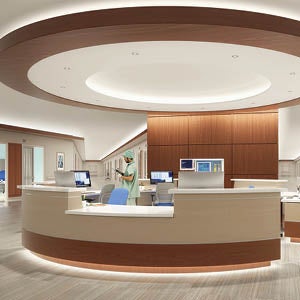
MULTIPLE USES
These solutions balance application requirements with aesthetics, resulting in spaces that are both hospitable and functional — from the parking lot to the nurses station. Cooper Lighting Solutions




